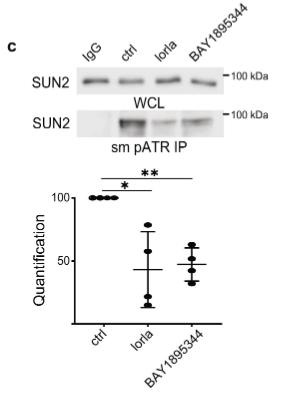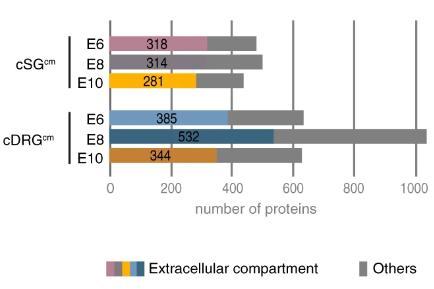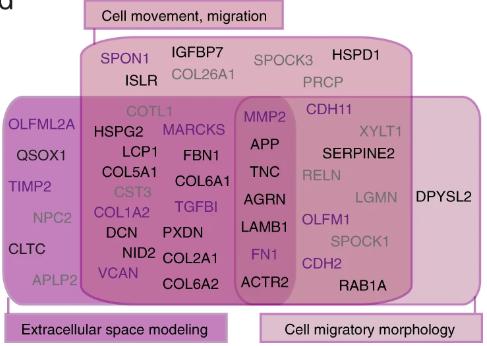Neuroblastoma is a cancer that develops from immature nerve cells found in several areas of the body. Neuroblastoma is most often found in or around the adrenal glands, which are similar in origin to nerve cells and located above the kidneys. However, neuroblastoma may also occur in the abdomen, chest, neck and near the spine where clusters of nerve cells are present. Neuroblastoma most often involves children 5 years of age or younger, but may occur rarely in older children.
Proteomics techniques are often applied in neuroblastoma research to provide data to support the mechanisms of neuroblastoma development, biomarker detection, and therapy development. A few case studies are shown below.
Case 1 Inhibition of ATR induces complete regression of ALK-driven neuroblastoma (1)
High-risk neuroblastoma (NB) often involves MYCN amplification and ALK mutations. Currently, there are significant clinical challenges in high-risk NB that require additional therapeutic options.
This study identified the presence of ATR activation in ALK-driven NB cells through phosphorylated proteomics results. Inhibition of ATR significantly hindered tumor cell growth and proliferation. It could even lead to complete regression of ALK-driven neuroblastoma. The response of NB cells and tumors to ATR inhibition was characterized by RNA sequencing, proteomics and phosphorylated proteomics, and key components of the DNA damage response were identified as ATR targets in NB cells. This study provides a potential opportunity for the treatment of high-risk neuroblastoma.


ATR signalling is required for survival in ALK-driven NB cell lines (Szydzik et al., 2021).
a Graphic representation of SUN2 protein with localisation of the phosphorylation sites regulated by ALK signalling activity. b Graphic representation of ATR protein structure with localisation of phosphorylation sites (S435, S436 and S437) regulated by ALK signalling activity. c Immunoprecipitation using ATR/ATM phospho-substrate motif antibodies in the presence or absence of ALK (lorlatinib) or ATR inhibitors (BAY 1895344) as indicated, followed by immunoblotting for SUN2 (WCL, whole-cell lysate; IP, immunoprecipitation) in CLB-BAR cells.
Case 2 Proteomics provides clues for neuroblastoma cell development studies (2)
NB cells are characterized by heterogeneity and transformation. The following steps were used to analyze the proteome of NB tumor cells. The proteins were dissolved in Laemmli buffers and heated at 95°C for 10 minutes. They were then separated by SDS-PAGE (4-12% nuupage, Life Technologies) and stained with Coomas bright blue R-250 (Bio-Rad). Digestion in gel was performed using modified trypsin (Promega, sequencing grade). The resulting peptides were analyzed by on-line nano liquid chromatography coupled tandem mass spectrometry.
A total of 236 proteins were identified from cSGcm and cDRGcm. 218 extracellular proteins were identified in E6 to E8 SGcm and DRGcm, mainly related to cell movement and migration, response to extracellular cues and signaling, metabolism and immune signaling.
108 extracellular proteins were detected in the medium affecting NB cells (E6-E8 cDRGcm and cSGcm), mainly involved in the modeling of extracellular space, cell movement and migration, and biological processes related to cell migration morphology, while almost none were detected in inactive cells (E10 cDRGcm and cSGcm). Then 35 related or homologous proteins, also identified in E15.5 mSGcm and mDRGcm, were extracted from these proteins, 12 of which have been reported to be associated with neural crest processes.

Fraction of proteins depicted to have an extracellular localization in each chick conditioned medium (Ben et al., 2022)

Candidate extracellular proteins present in conditioned media triggering NB loss of cell-cell cohesion and extracted from biological processes related to cell motility (Ben et al., 2022)
This study applied simulated embryonic models in combination with proteomic and transcriptomic studies and found that signals released from embryonic sympathetic ganglia, including Olfactomedin-1, induce a shift from norepinephrine to mesenchymal cells in NB cells and activate the promotion of NB metastasis.
Resources
- Szydzik, J., Lind, D. E., et al. (2021). ATR inhibition enables complete tumor regression in ALK-driven NB mouse models. Nature communications, 12(1), 1-18.
- Ben Amar, D., Thoinet, K., et al. (2022). Environmental cues from neural crest derivatives act as metastatic triggers in an embryonic neuroblastoma model. Nature communications, 13(1), 1-18.








